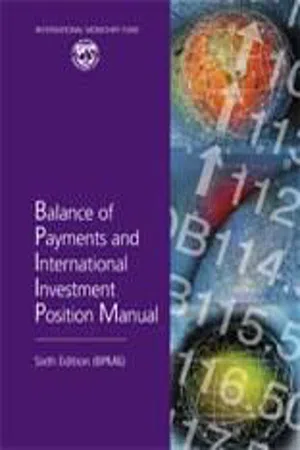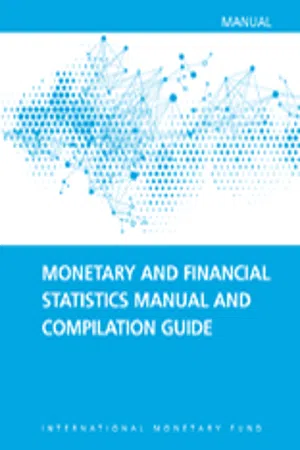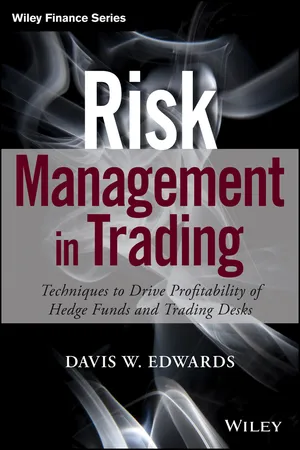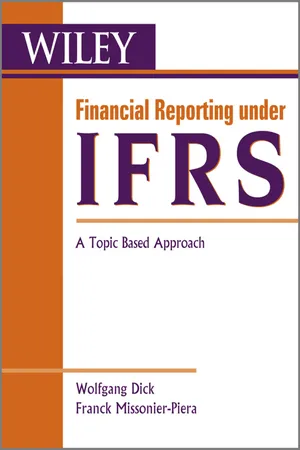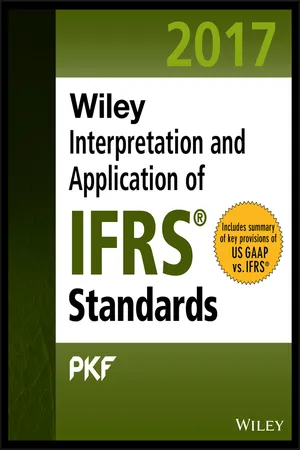Economics
Financial Assets
Financial assets are tradable instruments representing ownership of a claim on real assets or future income. They include stocks, bonds, cash, and bank deposits. These assets are valued based on their expected future returns and are essential for investors and businesses to allocate capital and manage risk.
Written by Perlego with AI-assistance
Related key terms
7 Key excerpts on "Financial Assets"
- eBook - ePub
- International Monetary Fund(Author)
- 2010(Publication Date)
- INTERNATIONAL MONETARY FUND(Publisher)
CHAPTER 5 Classifications of Financial Assets and Liabilities 5.1 This chapter discusses the classifications of Financial Assets and liabilities used in the international accounts. These classifications are applied to positions, the associated income and financial account transactions, and other changes involving Financial Assets and liabilities. Classifications are used to group similar components and to separate components with different characteristics. The international accounts functional categories and their relationship to the instruments classification are discussed in Chapter 6. A. Definitions of Economic Assets and Liabilities 1. Economic assets in general 5.2 Economic assets are resources over which ownership rights are enforced and from which future economic benefits may flow to the owner. They include fixed assets, such as equipment and research and development, that are used repeatedly or continuously in production over more than one year. They also include inventories, valuables, nonproduced assets, and Financial Assets. 5.3 Every economic asset has an owner. The economic owner of the asset is the party who has the risks and rewards of ownership. Rewards of ownership usually include the right to use, rent out, or otherwise generate income, or to sell the asset. The risks include the potential losses caused by damage, theft, and holding losses; that management, transfer, or maintenance costs are greater than anticipated; and, in the case of Financial Assets, default of the counterparty. Ownership may be subject to costs such as maintenance and taxes. Usually, the economic owner is the same as the legal owner, but they may differ in cases such as financial leases. Under some legal arrangements, elements of the risks and rewards are split between different parties, so it is necessary to identify which party has the bulk of risks and rewards to identify the economic ownership - eBook - ePub
An Introduction to Quantitative Finance
A Three-Principle Approach
- Christopher Hian Ann Ting(Author)
- 2015(Publication Date)
- WSPC(Publisher)
Chapter 2Brief Introduction to Four Major Asset Classes
2.1IntroductionIn simple terms, Financial Assets endow monetary values and utilities to the asset owners, giving them the freedom to re-invest, spend, donate, and whatsoever the owners want to do. A financial asset is either cash itself, or a legal contract called security, which mandates cash and other benefits to be transferred from one party to the other party according to the contractual terms and conditions. To own or hold an asset, the buyer typically has to pay for it. The seller, on the other hand, receives cash for liquidating the asset. With the advancements in information technology, zillions of asset transactions can now take place in the financial markets all over the world.There are many types of financial securities but the following four asset classes are the major ones: A. Equity or stock; B. Currency or foreign exchange; C. Commodity; D. Fixed income or debt instrument.A criterion used for selecting these four asset classes is that they are primarily the underlying assets on which derivatives are written. Derivatives are securities whose values depend on or derive from other securities. By contrast, the values of these four asset classes in general depend on the economic, financial, social, political, technological, weather, and many other external conditions directly. Another criterion is the volume of transactions and liquidity. These four asset classes are liquid, investable and tradable by both institutional and retail investors/traders.It goes without saying that a detailed discourse of each of these asset classes requires a separate book; by no means will the following sections do justice to the subject matter. Nonetheless, they provide an overall picture and pave the way for understanding the data characteristics of different asset classes. - Jose Cartas, and Artak Harutyunyan(Authors)
- 2017(Publication Date)
- INTERNATIONAL MONETARY FUND(Publisher)
4. Classification of Financial Assets and Liabilities
Passage contains an image
I. Introduction
4.1 This chapter describes the principal characteristics of Financial Assets and liabilities, and their classification by type of financial instrument within the framework of monetary and financial statistics. The recommended classification at its highest level follows that of the System of National Accounts 2008 (2008 SNA ). This chapter also includes three annexes: Annex 4.1 presents examples of debt securities issued through securitization; Annex 4.2 deals with the recommended treatment of accounts with the IMF in monetary statistics; while Annex 4.3 discusses topics related to Islamic financial institutions and instruments.4.2 Financial instruments comprise the full range of financial contracts made between institutional units. Financial instruments include Financial Assets and other financial instruments. Financial Assets have demonstrable value. Other financial instruments (e.g., financial guarantees, lines of credit, or loan commitments) are contingent or conditional upon the occurrence of uncertain future events. They are outside the Financial Assets boundary and therefore not included in the monetary and financial statistics (see paragraphs 4.220–4.221).Passage contains an image
II. Financial Assets and Liabilities
A. Definition of Financial Assets and Liabilities
4.3 An asset is a store of value, over which ownership rights are enforced and from which their owners may derive economic benefits by holding or using them over a period of time. Financial Assets are a subset of economic assets that are financial instruments.4.4 Most Financial Assets are financial claims arising from contractual relationships entered into when one institutional unit provides funds or other resources to another. These contracts are the basis of creditor/debtor relationships through which asset owners acquire unconditional claims on economic resources of other institutional units. The creditor/debtor relationship provides asset and liability dimensions to a financial instrument. From this a financial claim, and hence a liability, can be defined. There are no nonfinancial liabilities recognized in macroeconomic statistics; thus the term liability necessarily refers to a liability that is financial in nature.1- eBook - ePub
Risk Management in Trading
Techniques to Drive Profitability of Hedge Funds and Trading Desks
- Davis Edwards(Author)
- 2014(Publication Date)
- Wiley(Publisher)
CHAPTER 2 Financial MarketsThis chapter introduces many commonly traded financial products like stocks, bonds, futures, and options. These products are broadly grouped into real assets, Financial Assets, and derivatives. Then, these broad product types are further broken down to describe some unique features of the individual products that make up that general category.FINANCIAL INSTRUMENTS
Traders, whether individual traders or institutional traders like hedge funds, are in the business of buying and selling special types of contracts, called financial instruments. Financial instrument is a general term that refers to any type of tradable financial contract. Another term for financial instrument is security, as in securities markets. Originally, securities referred to instruments that provided an ownership right like stocks and bonds. However, in many jurisdictions, the term security now includes financial instruments that derive their value from commodities and from other financial instruments (derivatives).The three main types of financial instruments are real assets, Financial Assets, and derivatives. Real assets include physical commodities (like gold, oil, corn, or cattle), real estate, and legislatively created rights (like carbon emissions rights). Financial Assets are primarily composed of contracts that give an ownership interest in a company (stocks), borrowing (bonds), or currencies. Derivatives are financial contracts that derive their value from other financial instruments. For example, a derivative might be an agreement to buy a physical commodity at some point in the future (a futures contract) or a contract that gives its owner the right, but not the obligation, to purchase stock in a company (a stock option). (See Table 2.1 - eBook - ePub
Financial Reporting under IFRS
A Topic Based Approach
- Wolfgang Dick, Franck Missonier-Piera(Authors)
- 2011(Publication Date)
- Wiley(Publisher)
Cash, financial securities (stocks, bonds) and other short-term investments are part of what are broadly called the “financial instruments”. A financial instrument is cash, or a contractual right to receive cash or another financial asset from another entity, or a contractual right to exchange financial instruments with another entity under conditions potentially favourable or an equity instrument of another entity (IAS 32, §11). The company L’Oréal indicates in its annual report the components of its cash account (see Figure 3.1), itself a component of current assets. Held-for-trading Financial Assets are stocks, bonds and other derivatives (options, swaps, futures). They are valued at fair value with changes being recorded in the income statement (upwards or downwards) at the closing of accounts. There are three main categories of financial instruments in current assets: Financial Assets at fair value through profit or loss (a listed share, for example), the same assets classified as available for sale and derivatives (futures contract, option to purchase or sell, etc.). Assets at fair value through profit or loss represent securities held by the company in the hope of obtaining a gain in the short term (i.e. generally three months) and are more commonly called held-for-trading Financial Assets. The company has acquired these assets in order to generate profits in the short term, benefiting specially from market fluctuations. Available for sale Financial Assets are rather held as cash reserves on a short and medium term (but logically also expected to make profits). They can be classified as current or non-current depending on the objectives of the company during their possession - eBook - ePub
Financial Accounting
A Concepts-Based Introduction
- David Kolitz(Author)
- 2016(Publication Date)
- Routledge(Publisher)
expenses.2.5.1 The statement of financial position and the elements: assets, liabilities and equityThe elements directly related to the measurement of the financial position in the statement of financial position are assets, liabilities and equity. These elements are all defined in the IASB’s Conceptual Framework.Assets
An asset is:• a resource controlled by the entity• as a result of past events• from which future economic benefits are expected to flow to the entity.For a resource to be controlled by the entity, physical form and right of ownership are not essential. Many assets, for example property or equipment, have a physical form and are associated with the right of ownership. However, intangibles such as patents and copyrights may have no physical form other than a certificate of registration. They are, however, assets if they are controlled by the entity and future economic benefits are expected to flow from them. Equipment held on a lease is not legally owned by the lessee, but the substance of the agreement may give the lessee control over the benefits which are expected to flow from the equipment.Financial Assets, such as accounts receivable, are also a resource controlled by the entity. In the case of accounts receivable, when the entity has sold goods or provided a service to customers on credit, the resource controlled is the right to collect cash from the customers.In addition to tangible assets, intangible assets and Financial Assets, there are other assets, for example rent paid in advance, which also represents a resource controlled by the entity, namely the right to occupy the property.Pause and reflect…
a) A business entity sells goods on credit or on account to its customers. Selling on credit means that the customer agrees to pay the business entity for the goods at a later date. These customers are known as accounts receivable or debtors - eBook - ePub
Wiley IFRS 2017
Interpretation and Application of IFRS Standards
- (Author)
- 2017(Publication Date)
- Wiley(Publisher)
The elements of financial statements are the broad classifications and groupings which convey the substantive financial effects of transactions and events on the reporting entity. To be included in the financial statements, an event or transaction must meet definitional, recognition and measurement requirements, all of which are set out in the conceptual framework.The elements of a statement of financial position are:The following three characteristics must be present for an item to qualify as an asset:An asset is a resource controlled by the entity as a result of past events and from which future economic benefits are expected to flow to the entity.- The asset must provide probable future economic benefit, which enables it to provide future net cash inflows.
- The entity is able to receive the benefit and restrict other entities' access to that benefit.
- The event that provides the entity with the right to the benefit has occurred.
In addition, the asset must be capable of being measured reliably. The conceptual framework states that reliable measurement means that the number must be free from material error and bias and can be depended upon by users to give faithful representation. In the Basis for Conclusions of IFRS 2, the IASB notes that the use of estimates is permitted, and that there may be a trade-off between the characteristics of being free from material error and possessing representational faithfulness.Assets have features, which help to identify them in that they are exchangeable, legally enforceable, and have future economic benefit (service potential). It is this potential that eventually brings cash in to the entity and which underlies the concept of an asset.
Index pages curate the most relevant extracts from our library of academic textbooks. They’ve been created using an in-house natural language model (NLM), each adding context and meaning to key research topics.
